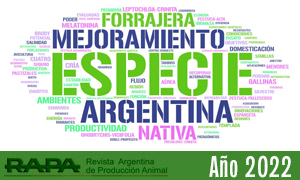Ver ítem
- xmlui.general.dspace_homeCentros Regionales y EEAsCentro Regional Catamarca - La RiojaEEA CatamarcaArtículos científicosxmlui.ArtifactBrowser.ItemViewer.trail
- Inicio
- Centros Regionales y EEAs
- Centro Regional Catamarca - La Rioja
- EEA Catamarca
- Artículos científicos
- Ver ítem
Productividad forrajera y estabilidad productiva de poblaciones de Leptochloa crinita (ex Trichloris crinita) evaluadas en cuatro ambientes del centro-noroeste de Argentina
Forage productivity and productive stability of Leptochloa crinita (ex Trichloris crinita) populations evaluated in four environments of the center-northwest Argentina
Resumen
En el centro-noroeste de Argentina (C-NOA) existen pocas opciones de especies forrajeras en el mercado de semillas para implantar pasturas en secano, y las pocas que hay son exóticas. En este contexto, surgió el interés de evaluar gramíneas nativas con potencial para incrementar la cobertura y productividad forrajera de campos de la región, siendo una de las especies que más atención recibe Leptochloa crinita (sinónimo: Trichloris crinita). En el presente
[ver mas...]
En el centro-noroeste de Argentina (C-NOA) existen pocas opciones de especies forrajeras en el mercado de semillas para implantar pasturas en secano, y las pocas que hay son exóticas. En este contexto, surgió el interés de evaluar gramíneas nativas con potencial para incrementar la cobertura y productividad forrajera de campos de la región, siendo una de las especies que más atención recibe Leptochloa crinita (sinónimo: Trichloris crinita). En el presente trabajo se evaluaron 11 poblaciones de L. crinita en cuatro ambientes del C-NOA (Salta, Catamarca, La Rioja, La Pampa), investigando tanto su productividad forrajera como su estabilidad productiva. El comportamiento de las poblaciones varió entre ambientes; las que más rendimiento presentaron en cada sitio de evaluación fueron: ‘San Martín’ en Catamarca y Salta (5136 y 4492 kg ha-1 año-1), ‘Recreo Salinas’ y ‘HC’ en La Pampa (5108 y 5004 kg ha-1 año-1), ‘Colpes’ y ‘El Tipán’ en La Rioja (3864 y 3820 kg ha-1 año-1). En general, la productividad forrajera por milímetro de lluvia fue mayor en Catamarca (11,4 kg mm-1) que en La Rioja y La Pampa (7,2 y 6,3 kg mm-1), y en éstas mayor que en Salta (4,4 kg mm-1). Las poblaciones ‘Recreo Salinas’, ‘San Martín’ y ‘SC’ (en ese orden) presentaron en general mayor productividad y eficiencia del uso de la precipitación y niveles medios de estabilidad productiva. Le siguieron con productividad, eficiencia y estabilidad algo menores ‘Colpes’, ‘SL’ y ‘El Tipán’. Las poblaciones ‘Salinas Grandes’ y ‘Chamical’ (ésta última corresponde al cv Chamical INTA) presentaron menor productividad y eficiencia del uso de la lluvia, y niveles de estabilidad medios-bajos. Los resultados señalan que hay germoplasmas promisorios en cuanto a su productividad y estabilidad. Estos hallazgos deben interpretarse en conjunto con otros de estudios donde se evalúan otros aspectos de las poblaciones, como su capacidad de geminación, crecimiento inicial, establecimiento a campo, entre otros.
[Cerrar]
For the center-northwest (C-NW) Argentina there are few options of forage species in the seed market to plant pastures, and they are exotics. In this context, interest arose in evaluating native grasses with the potential to increase forage productivity, being Leptochloa crinita (synonym: Trichloris crinita) one of the species that received most attention. In the present work, 11 populations of L. crinita were evaluated in four environments of the C-NW
[ver mas...]
For the center-northwest (C-NW) Argentina there are few options of forage species in the seed market to plant pastures, and they are exotics. In this context, interest arose in evaluating native grasses with the potential to increase forage productivity, being Leptochloa crinita (synonym: Trichloris crinita) one of the species that received most attention. In the present work, 11 populations of L. crinita were evaluated in four environments of the C-NW Argentina (Salta, Catamarca, La Rioja, La Pampa), investigating both their forage productivity stability. Performance of the populations varied between environments; those that presented the highest yield in each evaluation site were: 'San Martín' in Catamarca and Salta (5136 and 4492 kg ha-1 year-1), 'Recreo Salinas' and 'HC' in La Pampa (5108 and 5004 kg ha-1 year-1), 'Colpes' and 'El Tipán' in La Rioja (3864 and 3820 kg ha-1 year-1). In general, forage productivity per millimeter of rainfall was higher in Catamarca (11,4 kg mm-1) than in La Rioja and La Pampa (7,2 and 6,3 kg mm-1), and in these higher than in Salta (4,4 kg mm-1). The best performing populations, 'Recreo Salinas', 'San Martín' and 'SC' (in that order) presented in general high productivity and precipitation use efficiency and intermediate levels of stability. They were followed with somewhat lower productivity, efficiency and stability values by 'Colpes', 'SL' and 'El Tipán'. On the other hand, the populations 'Salinas Grandes' and 'Chamical' (this corresponds to the cv Chamical INTA) presented lower productivity and precipitation use efficiency, and intermediate to low stability levels. The results indicate that there are promising germplasms respect to their productivity and stability. These findings should be interpreted in conjunction with other studies where other aspects of the populations are evaluated, such as their germination capacity, initial growth and field establishment, among others.
[Cerrar]

Fuente
Revista argentina de producción animal 42 (2) : 41- 53. (2022)
Fecha
2022
Editorial
Asociación Argentina de Producción Animal
ISSN
0326-0550
2314-324X (Online)
2314-324X (Online)
Formato
pdf
Tipo de documento
artículo
Palabras Claves
Derechos de acceso
Abierto
 Excepto donde se diga explicitamente, este item se publica bajo la siguiente descripción: Creative Commons Attribution-NonCommercial-ShareAlike 2.5 Unported (CC BY-NC-SA 2.5)
Excepto donde se diga explicitamente, este item se publica bajo la siguiente descripción: Creative Commons Attribution-NonCommercial-ShareAlike 2.5 Unported (CC BY-NC-SA 2.5)


